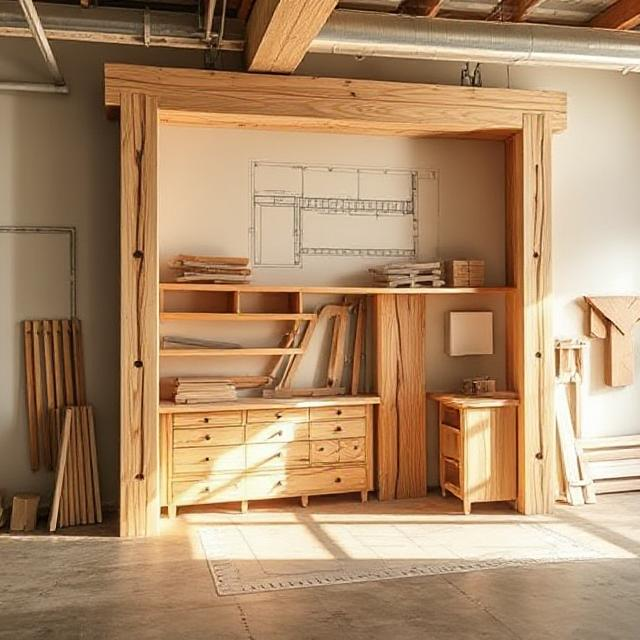
5 minute read
The Role of Millwork Drafting in Streamlining Construction and Reducing Errors
Millwork drafting plays a crucial role in the construction and interior design industries by ensuring precision, efficiency, and minimal errors in architectural woodwork. As the demand for high-quality craftsmanship and custom designs increases, the importance of millwork drafting services has grown significantly. Below, we answer some of the most common questions regarding millwork drafting and its role in streamlining construction processes while reducing costly mistakes.
What is Millwork Drafting?
A: Millwork drafting is the process of creating detailed technical drawings for custom woodwork elements used in construction, such as cabinetry, moldings, doors, wall paneling, and staircases. These drawings act as blueprints for manufacturers, contractors, and installers, ensuring that each piece is crafted and assembled with precision.
Why is Millwork Drafting Essential in Construction?
Millwork drafting is crucial in construction because it provides clear, accurate, and scalable drawings that serve as a guide for all stakeholders involved. Without these detailed plans, errors in measurements, material selection, and installation could lead to costly delays and rework. The key benefits of millwork drafting in construction include:
Enhanced precision: Eliminates guesswork and ensures that every component fits perfectly.
Time efficiency: Reduces delays caused by miscommunication or design flaws.
Cost savings: Prevents expensive mistakes and material wastage.
Seamless coordination: Ensures smooth collaboration between architects, contractors, and millwork manufacturers.
How Does Millwork Drafting Help in Reducing Construction Errors?
Errors in construction can lead to project delays, financial losses, and quality issues. Millwork drafting helps reduce errors in the following ways:
Accurate Measurements: Detailed millwork drawings include precise dimensions, preventing mistakes related to sizing and fit.
Material Specifications: Drafting includes material details, reducing the risk of incorrect materials being used.
Clash Detection: 3D millwork models can help identify potential clashes before production, avoiding on-site installation problems.
Clear Assembly Instructions: Detailed drawings provide a step-by-step guide for installers, minimizing confusion and human error.
What Are the Latest Trends in Millwork Drafting?
The field of millwork drafting has evolved significantly with advancements in technology. Some of the latest trends include:
Building Information Modeling (BIM): BIM integration in millwork drafting allows architects, engineers, and contractors to collaborate more effectively, reducing design conflicts and errors.
3D Visualization: Many firms are now using 3D modeling software like AutoCAD, Revit, and SketchUp to create realistic renderings before production begins.
Cloud-Based Collaboration: Digital platforms enable real-time collaboration, reducing miscommunication and ensuring all stakeholders are on the same page.
Automation and AI: AI-powered drafting tools can automate repetitive tasks, reducing manual errors and speeding up the drafting process.
How Does Millwork Drafting Improve Collaboration Among Construction Teams?
Collaboration is key in construction, and millwork drafting enhances teamwork in the following ways:
Standardized Documentation: Ensures that architects, contractors, and manufacturers follow a single source of truth.
Digital File Sharing: CAD and BIM software allow instant sharing of designs, making revisions and approvals faster.
Better Communication: Clearly labeled sections, materials, and dimensions minimize misunderstandings between different teams.
What Are the Common Challenges in Millwork Drafting, and How Can They Be Overcome?
While millwork drafting is highly beneficial, it also comes with some challenges, including:
Design Changes: Frequent modifications can lead to confusion and inconsistencies. Solution: Using cloud-based drafting software allows instant updates across teams.
Lack of Skilled Drafters: Not all drafters are experienced in millwork specifics. Solution: Investing in skilled professionals or training programs ensures better accuracy.
Misinterpretation of Drawings: If drawings are too complex or unclear, mistakes may occur. Solution: Providing clear annotations and 3D renderings improves understanding.
How Can Companies Implement Millwork Drafting to Maximize Efficiency?
To successfully implement millwork drafting in construction projects, companies should:
Use the Right Software: Invest in advanced drafting tools like AutoCAD, Revit, or Microvellum.
Train Employees: Ensure that drafters, engineers, and installers understand the importance of precise millwork drawings.
Standardize Drafting Procedures: Maintain consistency in how drawings are created and reviewed.
Adopt Digital Collaboration Tools: Use cloud-based platforms to share and update designs in real time.
Perform Regular Quality Checks: Review drawings thoroughly to catch potential errors before fabrication begins.
What Are the Cost-Saving Benefits of Millwork Drafting?
Millwork drafting reduces costs in multiple ways:
Minimizes Material Waste: Accurate specifications ensure only the necessary materials are used.
Prevents Rework: Well-drafted plans eliminate costly corrections and re-fabrication.
Reduces Labor Costs: Precise instructions lead to faster and error-free installations.
Optimizes Production: Manufacturers can produce millwork components more efficiently with clear, detailed drafts.
What Industries Benefit the Most from Millwork Drafting?
Millwork drafting is widely used in several industries, including:
Residential Construction: Custom kitchens, built-in storage, and decorative moldings.
Commercial Buildings: Office furniture, reception desks, and conference room interiors.
Retail Spaces: Store fixtures, shelving, and display cases.
Hospitality Industry: Hotels, restaurants, and luxury resorts require custom millwork for aesthetic appeal.
How Will the Future of Millwork Drafting Shape the Construction Industry?
The future of millwork drafting is likely to be driven by automation, AI, and increased digital collaboration. Emerging trends include:
AI-Driven Drafting: Artificial intelligence will automate repetitive tasks, improving speed and accuracy.
Virtual Reality (VR) and Augmented Reality (AR): These technologies will allow stakeholders to visualize millwork designs before fabrication.
Sustainable Millwork Drafting: More companies will focus on eco-friendly materials and efficient designs to reduce waste.
Advanced Parametric Design: Custom millwork will become even more precise with algorithm-driven designs that adapt to various constraints.
Conclusion
Millwork drafting services is an essential part of modern construction, streamlining workflows and reducing costly errors. With the integration of advanced drafting software, BIM, and cloud-based collaboration, the industry is shifting towards greater efficiency and precision. By embracing the latest trends and technologies, architects, designers, and contractors can optimize their projects, ensuring high-quality results and seamless execution.
Whether you’re a construction professional or a homeowner considering custom millwork, understanding the role of millwork drafting can help you make informed decisions and achieve outstanding results.










